Why wood boilers Heating remain popular aggregates for heating at home, because progress has long been holding up with time? The answer lies on the surface - the process does not always reach certain regions.
Gas highways are not extended everywhere, the installation of equipment is worth the fabulous money, with all sorts of permits from bureaucrats, electricity is expensive, liquid boilers carry more problems than benefits. Output one - use the traditional heating of housing. Everything in detail below.
The principle of action of the wood boiler and its types
It is simple - fuel combines with a large release of thermal energy. Air heating occurs if the boiler is not equipped with a water heat exchanger or pipe wiring system. Boilers are divided into the following types:
What to choose? The solution depends on the goals - if you purchase a boiler for the heating of a residential building, then the savings should be preferred, since the process will occur continuously.
But at the same time it is worth choosing a boiler, an automated and extensive system of emergency situations. When the question about the heating of a residential building is not worth it, the usual classic will be suitable - to warm up and boil some amount of water quite enough.
How to choose a wood boiler
The parameters for which it is important to pay attention to when buying will set the tone to the entire process. Therefore, treat it with all liability. So:Power
This is what is indicated as kW. Before the purchase, the heat loss should be calculated at home, which are also measured in these units. If you do this correctly, then the resulting digit and will mean the required power. There are several ways to calculate:
When the number is received, it should be added to it 20-30% of the total losses for the use of DHW or poor insulation of the house. The final digit can impress.
Material of manufacture
Firewood or pellets do not give a large temperature in contrast to coal. Therefore, choose between steel and cast iron, it will be much easier - cast iron is more expensive. In addition, it has a fragility in mechanical blows or carrier temperature drops.
Steel options look carefully and have significant mobility unlike heavy alloy. You can purchase a combination - steel housing and a cast iron heat exchanger. Then, water in the pipes will not cool much for a long time.
The volume of the furnace
Owners should not forget that the large size of the loading chamber is good only for classic boilers. In other cases, small spaces are used, which are fully filled, otherwise there will be nowhere to go from the heat, and the smaller load leads to the overflow of firewood.
Security
This parameter should be attributed to the protection against flame emissions, a smoke signaling device, anti-spare coating and other chips that make the process safe in all senses. All these devices are good only for constant boilers, that is, for heating residential buildings, not cottages, where owners appear only for the summer period.
Functionality
If the device's task is only home heating, then for the acquisition of a sufficiently single-mounted unit. To generate hot water, a wood heating boiler will be required with two contours. Such an installation is more cumbersome, as it contains a water tank, by type of boiler, where the temperature of the water is constant. You can purchase and flow options, but such good only for small houses With 1-2 points of water, otherwise the water simply will not have time to warm up.
Conclusion - to select a boiler on firewood, you should consider many parameters and then use will become really comfortable.
Requirements for the installation site of the wood boiler
Safety rules, unfortunately, violated everywhere. In order not to happen misfortunes - and the boilers belong to devices, high fire hazard, even with all protective systems - it is important not to take a disregard for the following:As for the maintenance of the wood boiler, everything is simple - regular cleaning of the ashtar and chimney, maintain optimal loading, checking security automation. You should not neglect the warranty period received from the manufacturer - if during this period any trouble happens, you should contact the service center immediately.
Opinions on wood boilers
Of course, any acquisitions are made based on the opinions of people already using an aggregate for heating. Someone is pleased, someone disappointed. It is worth seeing this very much. So, the wood-burning boiler for the heating of a private house - reviews on the result:
Firewood in the boiler Logano burns very quickly. Maybe because the boiler is a classic. It was necessary to take long burning. Well, so everything suits - warm at home, not lower than + 22⁰. Firewood is forced to warm up by the way.
Mikhail, Zakamsk
The boiler acquired a combined - gas-firewood. But while I am heating the house only wood, gas in perspective. We can say that there are no minuses, only a common bookmark at our strong frostsBut they are not frequent.
Before the purchase, pyrolysis was considered - I like the very principle of action, squeezes everything that is possible, but the pellets in our lands lack, and if you leave from afar - delivery expensive. I had to take a classic, but I do not regret it.
Alexander, Kaluga region
Svetlana, Fokino
These are such different reviews. However, the most often negative opinions come from the owners who did not take care in advance to warm their own home or incorrectly fit the unit according to the parameters described. It is important to pay attention to the choice even before purchasing that the boilers are woodcuts for heating a private house showed themselves from the best side.
Installing a prototype of a Russian oven in his own house, the owner provides a residential object in advance with a proven heating method. Environmentally friendly raw materials, productivity in the form of a large efficiency make wood-burning boilers for long burning or classic leaders among many units to create comfort in the house. It is worth using the tips of this article to choose their design and then live in the house will be much more comfortable and warmer.
After the purchase country house People are increasingly wondering how to install a wood boiler. In this case, it is often not about heating, but about heat heating for household needs. Agree, buy for this expensive equipment is hardly advisable, it will be cheaper to buildwood boiler do it yourself.
A wood boiler is a modern, somewhat improved an analogue of an ancient and well-known to each stove on firewood. Consequently, the principle of operation of this boiler is extremely simple.
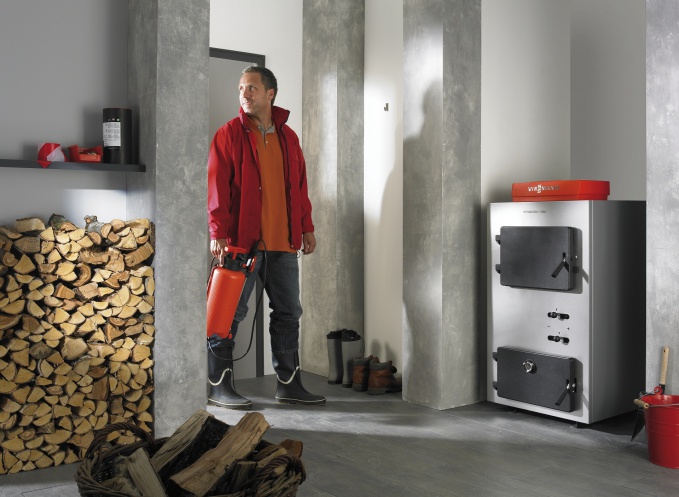

Firewood is placed in the fiber chamber, they burn there and transmit heat exchanger-free heat exchanger. The latter connected pipes transporting hot water In the overall heating network. With fuel burning, not only the coolant is heated. And the chimney pipe, and the boiler itself also participates in heat exchange, but only in the room where it is installed.
![]()
![]()
To remove the smoke that appears when burning fuel, chimney is installed. In the chimney also settles the soot - another product of the burning of the tree. If it is too much, then the thrust will deteriorate significantly.
Important! For timely purification of the chimney, they leave special holes closed with dampers. Cleaning is made long brushes.
It is worth noting that today, together with fuel, special substances contribute to cleaning the chimney during burning are often loaded.
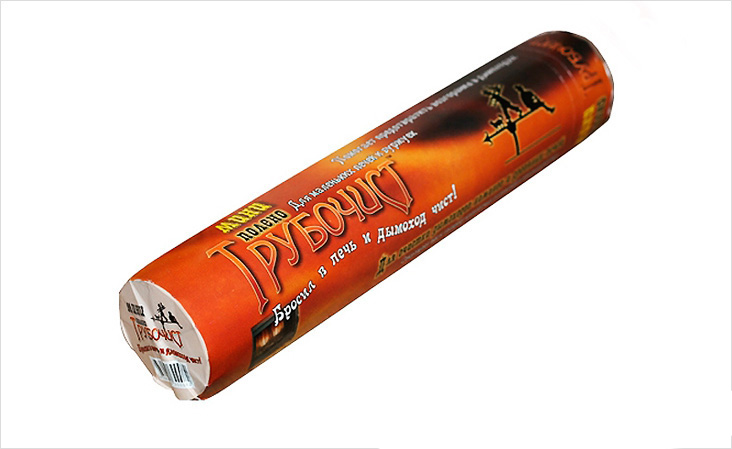

About modern wood boilers
Today's thermal generators of this type are almost perfect. After all, the technologies are developing and heating equipment, respectively, has undergone significant changes. Here are the main types of wood boilers:
- pellet:
- pyrolysis;
- open fireplaces.
Separately, it is worth talking about pyrolysis devices, which, when working not only the tree, is burned, but also the gas formed during the combustion process.
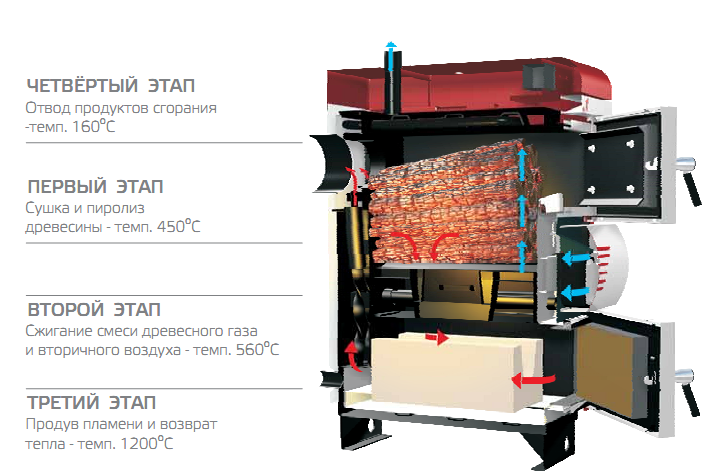

Pellet boilers use woodworking waste, compressable in special granules. If we talk about fireplaces, they carry the aesthetic load rather.
Where are used
Wood boilers are used primarily in populated areas located far from gas highways. It may seem that in such cases you can make a house with electricity, but in reality this energy is expensive and unstable.


Also, boilers on firewood are popular with dachensors who live on sites only on weekends. Home saunas and baths also do not cost without such boilers.
Important! In view of a minor power, such heat generators are inappropriate to apply for heating industrial facilities, but to create comfortable conditions in a small private house, it is quite enough.
Advantages and disadvantages
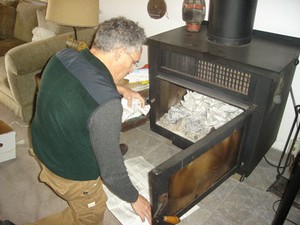

In wood boilers, like any other, have their strengths and weaknesses. Benefits include:
- autonomy from electricity - the owner may not be afraid of turning off electricity or voltage drops;
- ease of installation and operation;
- durability;
- ecology, because wood is a clean product that does not allocate any harmful and even more toxic substances during combustion; Although a carbon dioxide in non-compliance with the rules of fireproofing can be poisoned;
- low cost, which can still be reduced, if you independently make equipment;
- the availability of raw materials - for people living near forests, wood is free fuel.
It should also be noted that, along with firewood in boilers of this type, organic household waste can be burned (only solid, of course).
But there is similar equipment and disadvantages, among which:
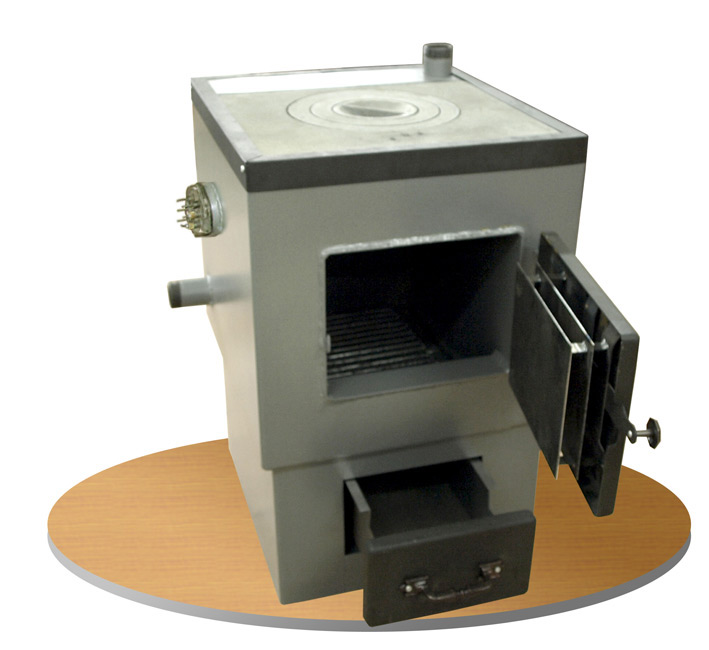
Obviously, all the disadvantages described are very significant, but among them there is nothing about the workpiece of firewood. Firewood needs to be found, bring to the site, chop, find a place for storage and constantly bring to the boiler, because one portion usually grabs two or three hours. Of course, if you wish the firewood, you can buy, but it is again additional costs.


Instructions for the manufacture of wood boiler
The usual woodwood water heater is made quite easily even without the use of complex equipment. The main task is to transform the combustion of fuel to the drainage, which makes it possible to increase the frequency of refueling and, as a result, reduce fuel consumption.
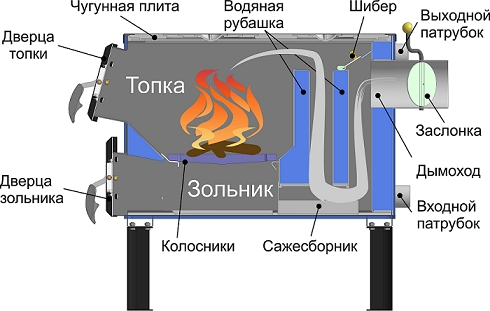

For the workpiece, it is desirable to use a metal 200-liter barrel with thick walls or a small (1 m in length) cut pipe with a diameter of 70 cm. Elements from the "stainless steel" use is not recommended, since the thermal conductivity of this material is quite low: more wood will be required for heating.
As a bottom, a metal circle of the corresponding diameter is used with a thickness of at least 5 cm. For support, 3-centimeter pieces of reinforcement are taken with a diameter of 12-14 cm. It will also require a blank for a grate - it can be a thick steel circle with longitudinal slots required for air supply to the fiber chamber And the fallout of ash. The third circle of 1 cm thick will also be required, which will serve as a boiler lid.
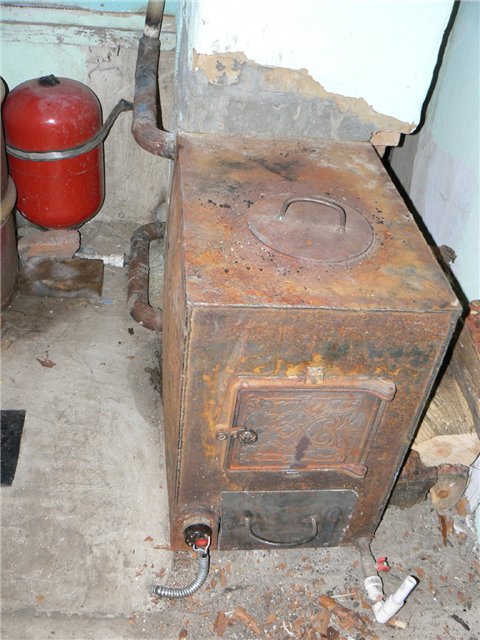

So, for the construction of a wood boiler, it is necessary to prepare the following materials:
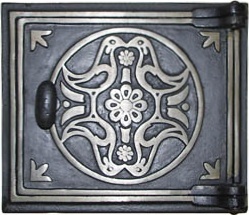
Now you can proceed directly to the manufacturing process.
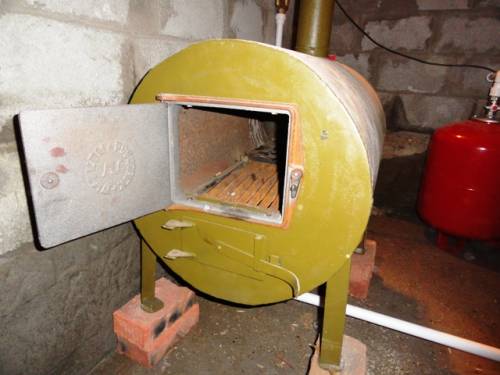

Procedure
The technology of manufacturing a wood boiler, as mentioned earlier, is extremely simple.
The first stage. Foundation
Under the wood boiler must lay out a solid foundation. For this purpose is used exclusively chammatory brick.
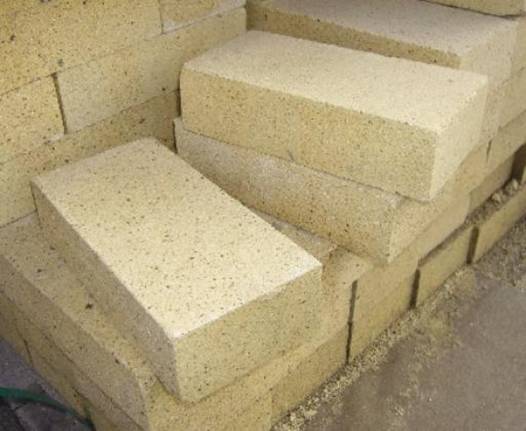

Stage second. Support
Then the reservoirs are welded inside the reservoir. Ponds need to be located in a horizontal position parallel to each other so that three levels formed.
- Level number 1 is the bottom of the heating device.
- Level number 2 is over the door pissed.
- Level 3 should be placed no longer than 20 cm from the construction cover.
Stage Third. Ku
One of the most important elements Any solid fuel boiler is the box. This box is divided into two parts (horizontally) - the first will serve as a susceptor, and firewood will be loaded into the second. For the installation of the box in the instrument housing (namely, the hole is made.
Important! The essence of the installation of this box is as follows: With it, you can pull the boiler from the adjacent room, which is especially convenient for the bath. In this case, the width of the box needs to be made at least the same as the thickness of the wall, through which it will pass.
Stage fourth. Pondered
Next you need to equip pissed. It is advisable to be made in the form of a nominating box - then you will not need to install the door. Moreover, with such a box it will be easier to brush the boiler from the accumulated ash and soot.
Stage fifth. Interior arrangement
The bottom of the construction is welded to the lower part of the body of the device. The grinding should be installed at the same level on which the top wall of the box is located. Then the chimney hole of the corresponding diameter is done in the furnace lid. The lid itself is also welded to the case.
Stage Sixth. Water heating tank
Water heaten capacitance is attached to the wall at a height of about 35 cm from the covers of the wood boiler. Water heating in the container will occur from the chimney pipe passing through it.
If the heating device is installed in the house, but it takes a hot water supply of other objects on a plot (both residential and economic), then the pipeline can be stretched.
Important! This pipeline should be covered with thermal insulation M material to avoid heat loss.
Stage seventh. Protective screen.
To prevent all sorts of tragic consequences, a homemade boiler must be protected by special protective screen. For the construction of such a screen, several carefully sharp wooden boards are taken, which are nailed to the bars in a horizontal position. There is another option - to build a fencing with a height of one meter from the brick, laid "on the edge".
Such a screen is necessary for the fencing of the hot body of the device from possible touches. Moreover, this is a good designer solution that can be used with a purely aesthetic purpose.


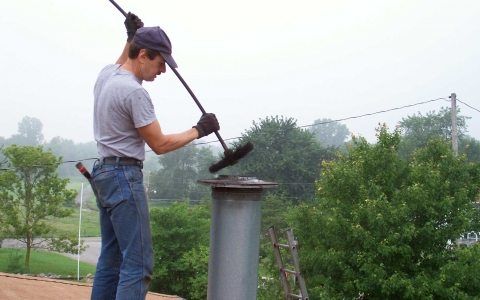
The number of accumulating soot depends on fuel and features of operation. So, coniferous trees give more soot. The use of raw wood, as well as poor-quality thermal insulation, leads to the formation of condensate. Ideally, it is necessary to trample solely with dry aspen lanes.
Video - Production of a wood boiler
The only problem with which winter holiday lovers may face, is the question of heating houses in winter timeBut he decide. Heating wooden house solid fuel boiler - this is the correct solution to the problem of heat in country house. By the way, solid fuel boilers Not only country houses, but also stationary wooden houses of rural residents can be hydrated.
The desire of a person maximize free time In nature is understandable and logical. Nothing does not restore the domestic reserves of the body as communication with wildlife. No wonder environmental (green) tourism is becoming increasingly popular in recent times. People return to abandoned cottages, build cottages and no longer so much in the goal on Earth, but to just take a break from the bustle and "of civilization". And those who want to meet new Year holidays Over the city is becoming more and more.
Oven or boilers
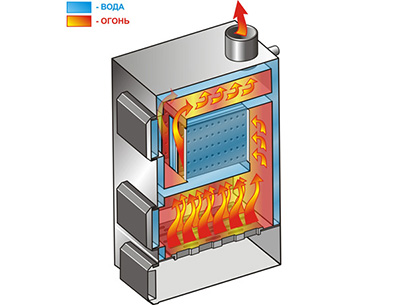
No gas, electricity supply interruptions This is not an apocalypse script, this is unfortunately quite real everyday life of the domestic depth. Our winters do not differ softness and coconut nuts on the streets do not grow, so it is necessary to warm up, and the stock of fuel for the winter period is a mandatory event that is not discussed.
To solve the housing heating problem:
- Kamenka stoves;
- . These devices already suggest the heating system with all the consequences arising from here, but it is a little later.
So, let's start solving the issue, how to make heating in wooden house with usual and familiar brick oven. Of course, this is a product that our ancestors were rightly proud, many tasks solved:
- Heating housing;
- Cooking food;
- It was a favorite sleeping place heated.
Currently, the role of a brick furnace in the heating issues did not decrease, the furnace continues to be operated and quite actively. The only one should not forget when using furnaces, this is about the rules of operation and fire safety:
- Any firebox is a fuel combustion chamber. Wood burns unevenly, while the process is possible to separate the burning fragments, with a definite distance, it is possible to depart a burning fragment when opening the door of the combustion chamber. To prevent floating floors on the wooden flooring, a strip of galvanized iron is stuffed. Iron can be replaced by ceramic floor tiles;
- In order to ensure the normal air movement in the system, the ash chamber must be clean, The air passing through the ash chamber, through grate to the combustion chamber should not meet obstacles in its path;
- Chimneys should be regularly examined so that they do not have foliage and other messages outside, and soot did not accumulate and did not hit the outgoing way out;
- When furnace firebox, part of the heat leaves with smoke, Therefore, there is a desire to overlap the upper plug as much as possible in order to prevent the fastest freezing of the pipe and the entire furnace complex. The plug closes completely only when the process of burning in the furnace is completed, otherwise the entire avgar will go to the house.
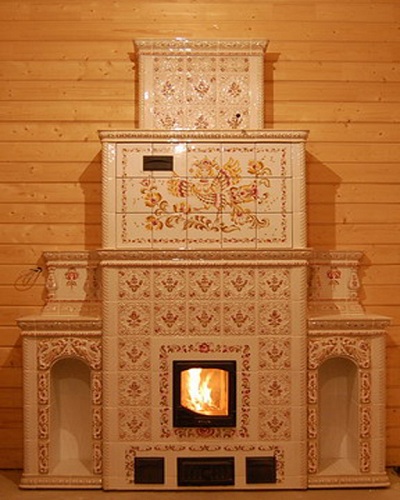
For your information! Humidity of firewood plays a very important role in the process of heating. So firewood containing up to 20% of moisture is doubled less heatthan dry. Hence the conclusion: Firewood and powder keep dry.
However, not everything is so good in stone ovens:
- They quickly heat and relatively quickly give warmly, you need several firewings, and this is an increase in flow;
- The stone oven will not be able to heat more than 100 square meters, and about two floors you can forget;
- The possibility of fire from coals and fugar from smoke in the furnaces remains very high.
Combined solutions are preferable
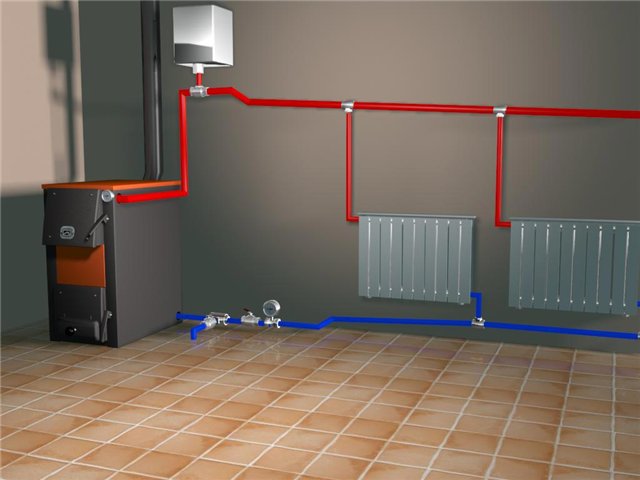
The heating of the village house has undergone some changes, as in principle, the rustic houses themselves. One-story country gradually go into the past, and the peasant house absolutely does not mean something small and incomplete. Wooden houses with a total area of \u200b\u200bmore than 100 square meters are already surprised.
How to dig a wooden house with such an area, answer:
- or setting several heat sources;
- or build water heating in a wooden house.
- The first option is discarded as unpromising. Imagine several stone stoves that have a double set of all positive and negative qualities, it is not only obligated, but also very troublesome.
- Second option - The heating system of a wooden house. This system is not much different from autonomy in a modern apartment on the one hand, and also practically no different from the furnace is another. Here is this system and the next chapter is dedicated.
From "hearts" going warm
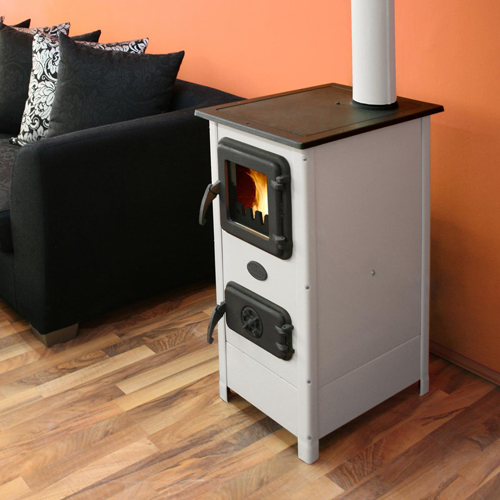
Installation of heating in a wooden house begins with the installation of the boiler. By itself, the boiler can be made of cast iron or from steel. As it does not paradoxically sound, but the insides of this product are practically no different from the internals of the usual oven.
There are:
- Coil;
- Combustion chamber - furnace;
- The same grates;
- The same system of removal of exhaust gas and smoke.
But there is one innovation that allows you to highlight boilers - these are water contours, (usually water).
For your information! There is one very important criterion that allows you to choose between the cast iron and the steel boiler. The fact is that the cast iron matters is relatively fragile, and what he does not like most, so it is sharp temperature drops, so if you decide to purchase a cauldron for a country house and use it from the case of the case, then the cast iron is not for you. Choose steel, it applies more calmly to temperatures.
Not a boiler one
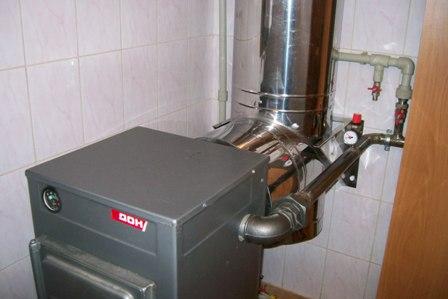
Indeed, only one boiler will not be able to solve all the problems, there are also pipes and radiator batteries, and another expansion tank, a pump, which is able to drive all the water to the destination and the security system will be completely unchecified (thermoaccumulators must be necessary).
Tip! If all the listed nodes and aggregates cause you only associative perception, then resolve the issue, how to spend heating in a wooden house. Leave masters. Wiring, docking, the choice of materials is already their concern.
Of course, it is possible to install the system with your own hands. Any instruction will tell you about such an opportunity. To pay attention to the installation:
- When choosing composite elements of the system (pipes, batteries, etc.), pay attention to the quality and timing of the warranty. It is clear that the price of high-quality products will be higher, but you do not have another exit - wooden walls of houses do not like and fear moisture;
- Reduce the number of risers, make a wiring for each floor;
- The presence of a compensatory, protective system is not discussed, it must be.
Finally
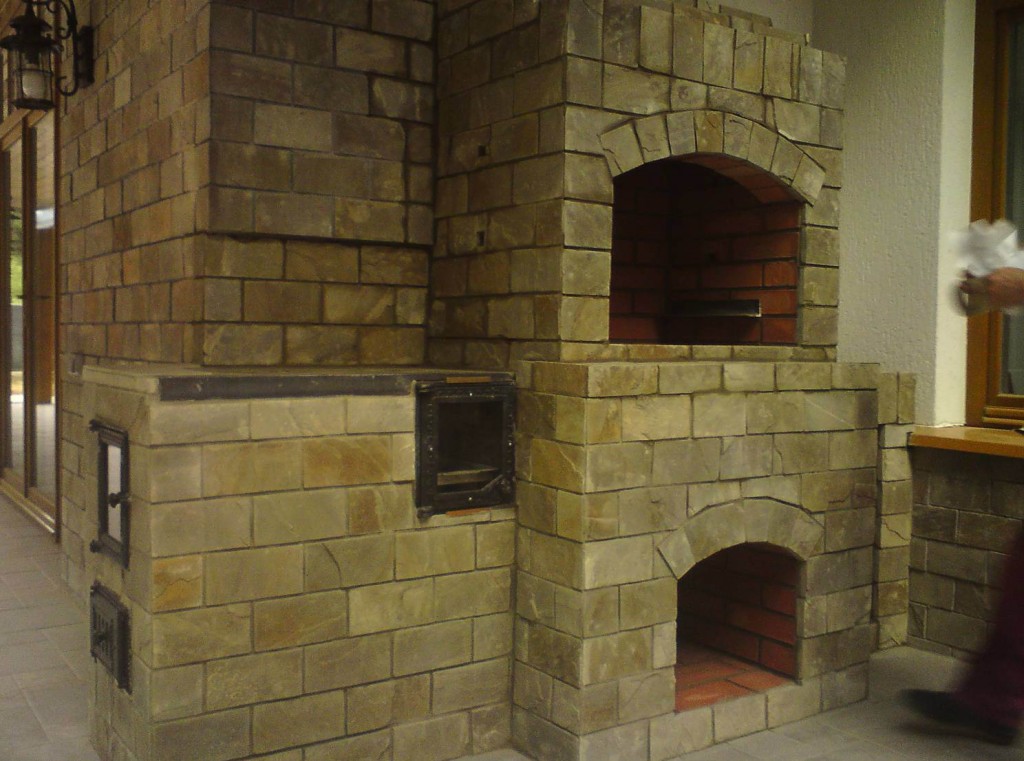
Wooden house is an environmentally friendly home, which has an increased fire hazard due to possible fire in the case of improper installation of a solid fuel boiler.
All surfaces of the solid fuel boiler have an elevated temperature due to heating in the furnace. In order to protect the house from ignition, you must follow the rules of fire safety.
 1. The installation of the boiler in a wooden house must be provided in advance to concrete foundation.
1. The installation of the boiler in a wooden house must be provided in advance to concrete foundation.
If the foundation is not provided, then it is necessary to build the basis of the Red fireproof brickswhich exceeds the size of the furnace at least 100-150mm. A asbestos sheet is laid on top of the brick, which prevents the heating of bricks from the boiler, then the steel sheet is placed, and the boiler is already installed on it.
Before the loading door, the metal sheet should go beyond the boiler at least 20-30cm so that in case of the furnace drops the spawn corner, it will fall onto the metal sheet, and not on the wooden floor.
2. Next an important point When installing, it is necessary to observe the distance of the boiler from wooden surfaces - walls. The boiler from the wooden wall should be at least 50cm in order to avoid fire and for possible boiler maintenance.
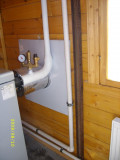 3. The moment the moment that it is necessary to pay attention is the passage of the chimney through wooden wall. The temperature of the exhaust gases is too high, so when the chimney pass through the outer wall in the wall, the square hole exceeds the chimney by 150mm from all sides is cut. The hole in the wall is filled with grainsite or non-combustible basalt cotton. Outside the house and inside the holes are closed with a special decorative steel stainless element - apron (sheet) purchased in a specialized store or manufactured independently. That is, with a pass through the wall, the hot chimney from all sides is protected by basalt cotton wool or clay.
3. The moment the moment that it is necessary to pay attention is the passage of the chimney through wooden wall. The temperature of the exhaust gases is too high, so when the chimney pass through the outer wall in the wall, the square hole exceeds the chimney by 150mm from all sides is cut. The hole in the wall is filled with grainsite or non-combustible basalt cotton. Outside the house and inside the holes are closed with a special decorative steel stainless element - apron (sheet) purchased in a specialized store or manufactured independently. That is, with a pass through the wall, the hot chimney from all sides is protected by basalt cotton wool or clay.
A similar device is performed when the chimney pass through wooden overlap or roof.
4. On the chimney it is necessary to provide a condensate trap. When operating the boiler in the winter period, the temperature of the removal gases is too high, and the outdoor temperature is low, therefore condensate is formed on the walls of the chimney, which must be removed from the chimney walls to avoid rapid corrosion formation on the walls.
5. It is necessary to provide an excavator.
6. Install an umbrella on the chimney head board.
Thus, after installing a solid fuel boiler, it can be tied up and connect the heating system.
What you need to install a solid fuel boiler.
To install a solid fuel boiler
- The room is sufficient to install the boiler with a window and a door.
- The foundation is concrete or brick for the base device under the furnace.
- Asbestos leaf and steel galvanized leaf size 150 mm more than the boiler size.
- Ceramzit or basalt cotton wool.
- Steel stainless element - apron for passing through the wall on both sides.
- Chimney from stainless steel with insulation and fastening elements for fixing the chimney to the wall.
- Solnik and umbrella for chimney.




